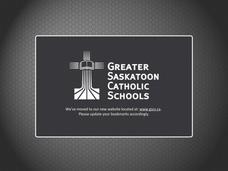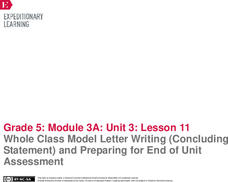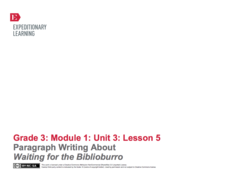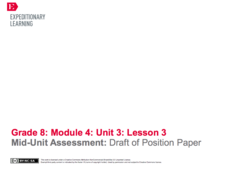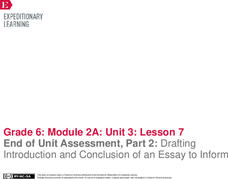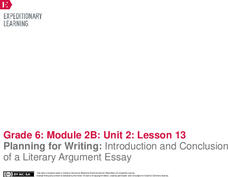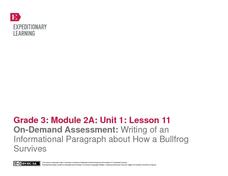EngageNY
Planning the Introductory and Concluding Paragraphs of the End of Unit Assessment Essay
Preparation is the key to success! Using the guiding resource, scholars plan their end-of-unit analytical essays' introductory and concluding paragraphs based on their reading of Inside Out & Back Again. To prepare, they complete a...
Curated OER
Basic Five Paragraph Essay
Introduce your young writers to the basic five-paragraph essay. The fun part of this presentation is the stance of the essay used to illustrate the format. The writer of the model essay contends that the Twilight series is a terrible...
Curated OER
Five-Paragraph Essay
The great thing about this presentation on the traditional five-paragraph essay is the color coding. Each aspect of the essay is followed by a concise description and an example. Then a complete paragraph is presented with the key...
EngageNY
Whole Class Model Letter Writing (Concluding Statement) and Preparing for End of Unit Assessment
Pupils work in small groups to collaboratively write a concluding paragraph for their opinion letters about Jackie Robinson's legacy. Then, scholars share their opinion, reasons, and evidence with a classmate.
EngageNY
Paragraph Writing About Waiting for the Biblioburro
Ask your learners to synthesize what they know about Waiting for the Biblioburro by writing a well-organized paragraph. Young writers focus on using transition words and including specific details in their paragraphs. The plan allows for...
Curated OER
The Five-Paragraph Essay: Tips for Success!!
Need to review the five-paragraph format with your high schoolers? Although the presentation does not include a complete essay as a model, the concise definitions and explanations would serve as a good review before learners are assigned...
EngageNY
Grade 9 ELA Module 4, Unit 1, Lesson 27
Crafting a clear and cohesive conclusion to any piece of writing is crucial. An effective conclusion restates the central claim in the introduction, briefly summarizes the supporting claims, and presents a new way of thinking about the...
EngageNY
Mid-Unit Assessment: Draft of Position Paper
What is the purpose of an introduction and conclusion? Using the resource, scholars review the model position paper from activity one and discuss the author's choices. Next, they draft their position papers' introductory and concluding...
EngageNY
End of Unit Assessment, Part 2: Drafting Introduction and Conclusion of an Essay to Inform
A powerful introduction and conclusion can really pack a punch. Using the resource, scholars first read and discuss a model essay. Then, as part of the end of unit assessment, they draft the introductory and concluding paragraphs of...
Ohio Literacy Resource Center
Writing a Well-Structured Paragraph
Practice with paragraphs while thinking about careers! Learners examine and discuss two sample paragraphs, marking the different elements (topic sentences, body, concluding sentences), and try out writing their own paragraphs. Focusing...
Curated OER
The Paragraph
Review the components of a well-written paragraph with your class. Be sure your writers include a topic sentence supported with main ideas and followed by a conclusion. Unity, coherence, and transition words are emphasized. Experiment...
Curated OER
The Paragraph
Now that they've mastered the word and the sentence, it's time to tackle the paragraph. This strong presentation provides all the basic information needed to help learners construct well-organized paragraphs. The topic sentence,...
EngageNY
Planning for Writing: Introduction and Conclusion of a Literary Analysis Essay
First and last impressions are important. Using the helpful resource, scholars draft the introductory and concluding paragraphs of their literary analysis essays. Next, they use a writing evaluation rubric to self-assess their work.
EngageNY
Planning for Writing: Introduction and Conclusion of a Literary Argument Essay
Give a powerful introduction. Scholars analyze the introductory paragraph in the model essay "Are We Medieval?: Opportunities in the Middle Ages and Today." They discuss the key components the author includes and then walk through the...
Curated OER
8-Sentence Accordion Paragraph Practice
Organization can take a paragraph from mundane to first-rate. Try out a graphic organizer for an accordion-style paragraph, which includes a topic sentence, three reasons with details and transitions, three explanations, and a concluding...
EngageNY
Writing a Second Body Paragraph and Conclusion for an Opinion Essay: Jackie Robinson’s Role in the Civil Rights Movement (Promises to Keep, Pages 50–57)
Class members begin to work on the body paragraphs of their opinion essays about Jackie Robinson started in the previous lesson. They analyze a model paragraph and underline reasons for the opinion. Learners then take part in a mini...
EngageNY
On-Demand Assessment: Writing of an Information Paragraph About How a Bullfrog Survives
Having read and discussed Bullfrog at Magnolia Circle, third graders demonstrate their bullfrog expertise by writing informational paragraphs. Building on the note-taking and paragraph planning from the previous lesson plan, learners...
Curated OER
The Five-Paragraph Essay: A Framework for Expository Writing
Looking for a PowerPoint presentation that models the framework for the traditional five-paragraph essay? Look no further. Here, the brief explanations are clear and concise, and color codes indicate the thesis sentence, the topic...
EngageNY
Drafting Introduction and Conclusion
In conclusion ... Scholars analyze the model essay Adversity Faced by Townspeople in
the Middle Ages to gain a better understanding of introductory and concluding paragraphs. After studying the author's strategies, learners begin writing...
EngageNY
End of Unit Assessment, Part 2: Drafting Introduction and Conclusion of a Narrative
First and last impressions matter. Scholars compose the introductory and concluding sections of their narrative writing assignments. Also, to prepare for an upcoming performance task, pupils watch a modern-day monologue from the movie...
jc-schools
Moving to the Five Paragraph Narrative Essay: A Write On Activity
Ready to introduce your young writers to the multi-paragraph essay? Here’s an illustrated presentation that models how to use the pre-writing notes on a graphic organizer to craft a personal essay. Color codes help viewers identify the...
Curated OER
Basic Paragraph
Explore basic paragraphs. Young writers compose a topic sentence, supporting sentences, and a concluding sentence. This lesson plan is intended for use with a SMART Board, a software technology web link is induced.
Curated OER
Develop a Paragraph
Need a recipe for a paragraph? Young writers cook up the opening paragraph for a speech on food preparation. They prepare by reading the directions and cutting out the provided sentence strips. Then, they mix up the strips and paste the...
Curated OER
How to Write an Essay: Secondary ed.
Whether introducing the structure of expository essays or reviewing the format with your high schoolers, take the time to check out this resource. Examples of seven common forms of introductory paragraphs and six types of conclusions, as...




